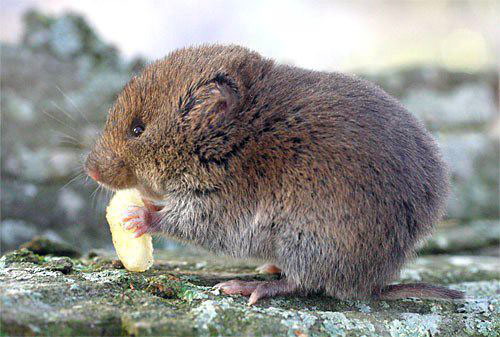|
|
|||
|
|
|||
Back to Preceding Week; on to Next Week
|
VOLES, NOT MOLES As we gaze at feeders outside our office window at Hilton Pond Center, we are sometimes distracted from birdwatching by a rustling among dead leaves that carpet the winter landscape. Most days, Eastern Chipmunks and Gray Squirrels forage frenetically in leaf litter for acorns and other goodies, but the activity that catches our eye is much more subtle. A leaf will move an inch or so for no obvious reason, followed by one more, then another, and another. When we focus our binoculars on these moving leaves, we see they follow an irregular line, and with patience we may even get to see the cause of the movements.  All text & photos © Hilton Pond Center Occasionally, a tiny, blunt snout will appear from beneath a dead leaf, sniff the air, only to disappear a few seconds later. If we're really lucky a small, dark animal will emerge and scurry around in the open for a moment of two, revealing its identity as a Pine Vole. The Pine Vole (eating a piece of apple, above) is a mouse-like rodent found almost everywhere in the eastern half of the U.S. except for northern Maine, southern Florida, and sandy coastal areas. The Carolinas host three congeneric voles--Pine Vole, Microtus pinetorum; Meadow Vole, M. pennsylvanicus (which occurs mostly north of South Carolina); and Rock Vole, M. chrotorrhinus (found only in the Mountain Province and northward). A fourth more distantly related species--the Southern Red-backed Vole, Clethrionomys gapperi--occurs in North Carolina's mountains and up the Appalachians into Canada. Although the term "mouse" is sometimes used in place of "vole" for all these species, mice have tails about as long or longer than their body length, while vole tails are considerably shorter and their snouts are more blunt. Pine Voles are our smallest species, measuring up to 5.5" in length with very short 1" tails; they weigh less than an ounce and a half. Despite their name, Pine Voles are seldom found in coniferous forests, preferring instead to inhabit meadows or deciduous woods--hence their alternate and more descriptive name of "Woodland Vole." Pine Voles have chestnut-brown pelage that blends to a silvery gray on the belly (male, below left); the back is lighter in juveniles. In South Carolina's Piedmont Region the species may breed year-round, but north of here reproduction probably ceases in winter. Pine Voles aren't quite as prolific as some small rodents, producing only one to five young per litter rather than six or more. Gestation lasts about three weeks, and young are weaned another 18 days or so after birth. Females become reproductively active as young as two months of age and may produce up to five or six litters in their 18-month lifespans. Pine Vole pairs appear to be monogamous. Since the species is semi-colonial, normal population densities of Pine Voles can reach 50 or so individuals per acre, with as many as 300 individuals reported in one acre of a New York apple orchard! With this kind of crowding, Personally, we happen to like Pine Voles. They seldom bite when handled and we appreciate the way they fit into the natural scheme--sometimes as prey items, sometimes as consumers of beetle grubs and old persimmons. We welcome Pine Voles here at Hilton Pond Center and relish the opportunity to watch as they rustle up leaves while foraging for leftover seeds beneath our mid-winter bird feeders. If you enjoy "This Week at Hilton Pond," please help Support Hilton Pond Center for Piedmont Natural History. It's painless, and YOU can make a difference! You may wish to consult our Index of all nature topics covered since February 2000. For a free, non-fattening, on-line subscription to "This Week at Hilton Pond," just send an e-mail with "Subscribe" in the subject line to THIS WEEK |
|
Make direct donations on-line through
Network for Good: |
|
|
LIKE TO SHOP ON-LINE?
Donate a portion of your purchase price from 500+ top on-line stores via iGive: |
|
|
Use your PayPal account
to make direct donations: |
|
|
SPECIES BANDED THIS WEEK * = New species for 2003
NOTABLE RECAPTURES (with original banding date, sex, and current age) Chipping Sparrow (5) 01/25/00--after 4th year unknown 02/27/00--after 4th year unknown 03/19/00--after 4th year unknown 03/15/01--after 3rd year unknown 03/30/02--after 2nd year unknown Dark-eyed Junco (5) 11/12/01--3rd year female 02/23/02--after 2nd year female 02/27/02--after 2nd year unknown 03/12/02--after 2nd year female 03/21/02--after 2nd year female American Goldfinch (1) 02/10/02--3rd year female Song Sparrow (1) 11/19/01--after 2nd year unknown Northern Cardinal (4) 07/30/01--3rd year female 07/20/02--2nd year male 07/29/02--2nd year female 09/06/02--2nd year male Eastern Towhee (1) 07/17/02--2nd year male
VAGRANT HUMMINGBIRDS None banded this week. |
 Individuals of this species--common year-round in the Carolina Piedmont--show great variability in the intensity of yellow head and breast coloration. Adult males are typically brighter, but all ages and sexes show white wingbars and outer tailspots.
WEEKLY BANDING TOTAL YEARLY BANDING TOTAL (2003) 15 species 326 individuals BANDING GRAND TOTAL (since 28 June 1982) 123 species 42,440 individuals SIGHTINGS OF INTEREST --Another 1.2" of rain this week not only filled up Hilton Pond but actually caused water to spill over the spillway--the first time this has happened in four years. --Strong winds gusting to 50-60 mph knocked loose most of the remaining "widow-makers"--limbs hanging perilously overhead since being broken during the devastating December ice storm that hit the Hilton Pond Center. --Two pairs of Wood Ducks courting on Hilton Pond for the past several weeks have been joined by a third male and two more females. |
|
Up to Top of Page Back to This Week at Hilton Pond Center Current Weather Conditions at Hilton Pond Center |
 post questions for The Piedmont Naturalist |
 Nature Study Network |
Search Engine for |
|
|